Understanding Pragmatic Language Difficulties In Autism
Decoding Pragmatic Language Challenges in Autism
Pragmatic language difficulties are a defining characteristic of Autism Spectrum Disorder (ASD), impacting social communication and interaction from early childhood into adulthood. These challenges extend beyond mere language deficits to encompass the nuanced social use of communication, including conversational skills, non-verbal cues, and adapting messages to context. Understanding these impairments is vital for effective diagnosis and intervention, and this article explores assessment tools, contributing factors, behavioral correlations, and evidence-based therapies that target pragmatic language in autistic individuals.
Role of Pragmatic Language in Autism Spectrum Disorder

What is pragmatic language and why is it important in autism?
Pragmatic language involves the social use of spoken language — knowing how to manage conversations, follow conversational rules, use gestures, tone, and adjust speech to fit different social situations. This includes skills like topic management, turn-taking, interpreting implied meanings, and reading social cues.
For children with Autism Spectrum Disorder (ASD), pragmatic language is especially challenging. These difficulties often show up early, even in preschool years, and are a core characteristic of autism. They affect not only how children communicate verbally but also how they engage non-verbally with others, such as using gestures or making eye contact.
Why is pragmatic language key in ASD diagnosis and social interaction?
Pragmatic language deficits are reliable markers in diagnosing ASD and distinguishing it from other developmental disorders like ADHD. Tools like the Children’s Communication Checklist-2 (CCC-2) focus on these pragmatic skills to identify social communication deficits that are less influenced by factors like IQ.
In ASD, these pragmatic challenges correlate closely with the severity of social impairments, impacting the ability to build relationships, participate in conversations, and regulate behaviors. Difficulties with pragmatic language can also contribute to externalizing behaviors such as anxiety, ADHD symptoms, and oppositional behaviors.
Overall, pragmatic language underpins successful social interaction, which is often compromised in autism, making it a critical area for assessment and intervention focusing on improving social communication and quality of life.
Early Emergence and Developmental Trajectories of Pragmatic Skills in Autism
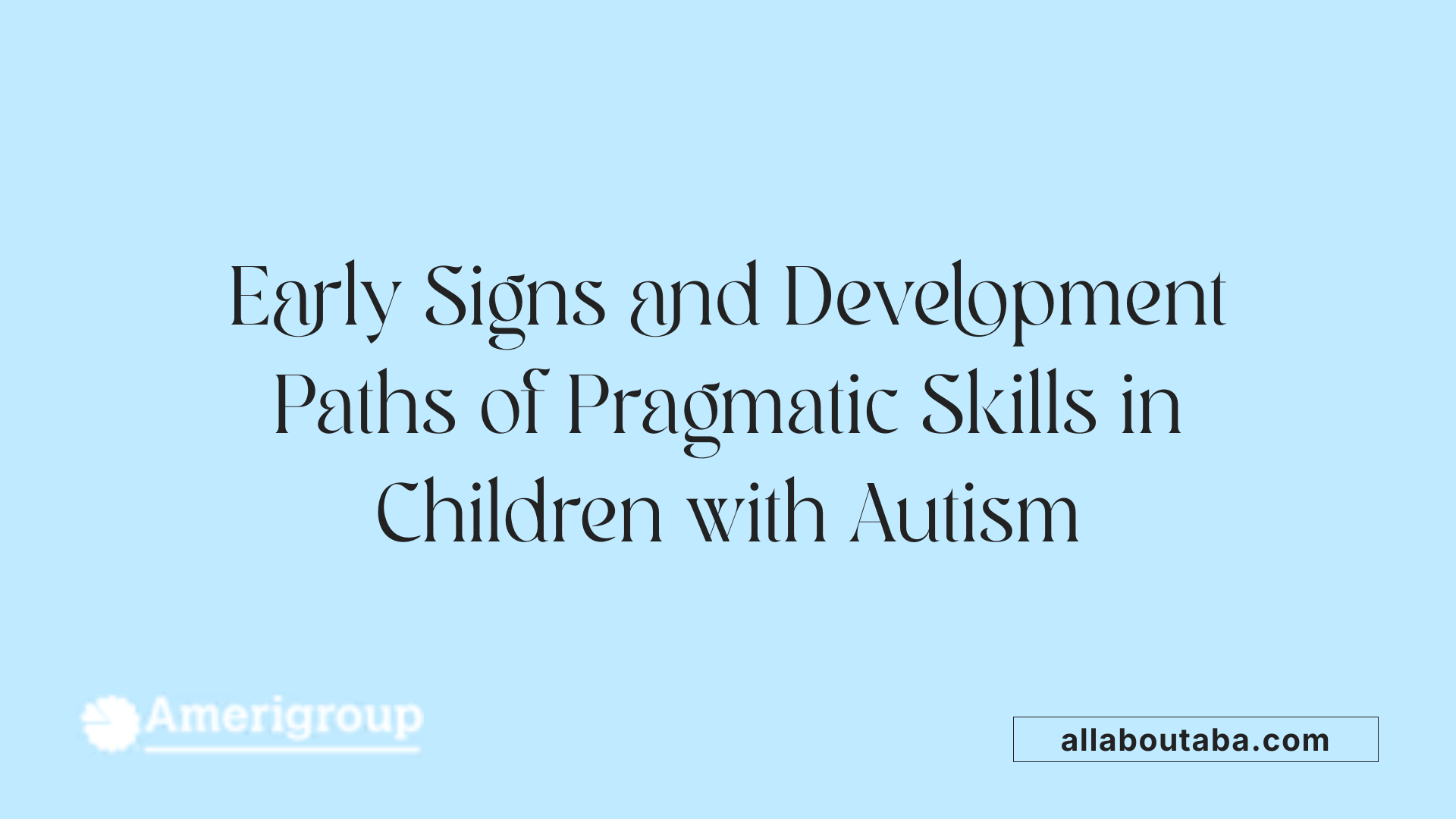
When do pragmatic language difficulties appear in children with autism?
Pragmatic language difficulties in children with autism appear as early as the preschool years. These challenges begin even before spoken language develops, during prelinguistic stages such as gestures, vocalizations, and joint attention behaviors. Children with ASD often show impairments in these early pragmatic skills, which are foundational for later social communication.
Prelinguistic pragmatic behaviors
Before children with autism start using words, they typically engage in important social behaviors like pointing, eye contact, and shared attention with caregivers. These prelinguistic acts help lay the groundwork for understanding social cues and conversational turn-taking. In autism, reduced frequency and quality of these behaviors can signal early pragmatic language challenges.
Development into adolescence
Pragmatic language skills continue to evolve well into adolescence, encompassing abilities like adjusting speech based on context, understanding implied meanings, and managing conversations. However, many individuals with ASD experience persistent difficulties in these areas over time, which can affect their social interactions and relationships throughout their development.
Persistent difficulties as risk factors for behavioral problems
Continued impairment in pragmatic skills is linked to increased risk of externalizing behaviors such as anxiety, disruptive conduct, and oppositional defiant behaviors. Research suggests that early pragmatic deficits serve as indicators of potential behavioral challenges later in life, emphasizing the importance of early identification and intervention targeting social communication abilities in children with autism.
Assessment Tools for Pragmatic Language in ASD

What are the prominent tools used to assess pragmatic language in children with Autism Spectrum Disorder?
Assessing pragmatic language skills in children with ASD involves multiple established tools to capture the complex nature of social communication. The Children’s Communication Checklist, 2nd Edition (CCC-2) is one of the most effective parent-report measures, widely used to evaluate pragmatic language differences by gathering detailed observations from parents about their child's communication abilities in everyday settings. Its pragmatic language scores robustly differentiate ASD from typically developing children and other clinical groups such as ADHD.
Another key instrument is the Social Responsiveness Scale, 2nd Edition (SRS-2), which is utilized mainly to measure the severity of social impairment in ASD. Research reveals strong correlations between pragmatic language difficulties on the CCC-2 and social responsiveness scores on the SRS-2, emphasizing the interplay between pragmatic challenges and social deficits.
The Test of Pragmatic Language (TOPL) is a clinician-administered assessment targeting various pragmatic facets including conversational rules, interpretation of non-literal language, and adjusting speech to social contexts. It is often paired with parent reports to provide a comprehensive clinical profile.
How are parent-report measures and clinician assessments utilized together?
Parent-report tools like the CCC-2 offer ecologically valid insights by reflecting real-world communication behaviors, while clinician-led assessments such as the TOPL provide structured observations that can explore subtle pragmatic nuances. Combining these modalities enriches the understanding of each child's unique profile and guides intervention strategies.
Are neuroimaging techniques used in pragmatic language assessment?
Though less common in routine clinical settings, advanced neuroimaging modalities like Magnetic Resonance Imaging (MRI) contribute to research exploring brain mechanisms underlying pragmatic impairments in ASD. Imaging studies highlight involvement of neural regions including the medial prefrontal cortex and temporal lobes, deepening the scientific understanding that may inform future diagnostic and therapeutic approaches.
Together, these tools—behavioral assessments, parent reports, and neuroimaging—form a multidisciplinary framework enabling accurate diagnosis, severity monitoring, and evaluation of intervention effects on pragmatic language skills in children with ASD.
Advantages of Parent-Report Tools in Pragmatic Language Evaluation

What makes parent-informant measures ecologically valid?
Parent-report tools like the Children’s Communication Checklist, 2nd Edition (CCC-2) gather insights from those who observe children in natural social environments daily. This ecological validity means parents provide crucial perspectives on children's pragmatic language skills as they occur naturally, rather than limited snapshots seen only in clinical settings.
How do parent-reported measures complement clinical assessments?
Parent-report measures serve as valuable complements to clinician-led evaluations by offering continuous and broad-based data on a child’s pragmatic language use. They help differentiate children with autism spectrum disorder (ASD) from typically developing peers and those with conditions like ADHD, especially because pragmatic scores tend to be less influenced by intelligence quotient (IQ) factors than structural language scores.
Why are parent reports essential for monitoring development and interventions?
These tools enable ongoing monitoring of pragmatic language development over time. Research supports their use in tracking intervention outcomes, as improvements noted by parents often align with reductions in social impairments and externalizing behaviors. Parent involvement also facilitates the generalization of skills across settings, enhancing long-term success in pragmatic communication.
Collectively, parent-report tools provide reliable, ecologically valid, and practical ways to assess and support pragmatic language development in children with ASD, reinforcing their role in comprehensive clinical care.
Differentiating Autism from ADHD through Pragmatic Language Scores
How do pragmatic scores differentiate children with ASD from those with ADHD?
Pragmatic language scores, particularly from assessments like the Children’s Communication Checklist, 2nd Edition (CCC-2), serve as powerful tools in distinguishing children with Autism Spectrum Disorder (ASD) from those with Attention Deficit Hyperactivity Disorder (ADHD). These scores capture nuances in social communication skills that are significantly different between the two groups. While children with ADHD often display externalizing behaviors, their pragmatic language weaknesses are generally less pronounced compared to children with ASD, making pragmatic scores a strong discriminative marker.
Are pragmatic scores influenced by intelligence quotient (IQ) levels?
An important advantage of using pragmatic language scores over structural language measures is that they are less affected by a child’s intelligence quotient (IQ). Structural language skills, which involve vocabulary and grammar, can be heavily influenced by cognitive abilities. However, pragmatic language—centered on using language appropriately in social contexts—remains a stable metric regardless of IQ differences. This makes pragmatic scores particularly useful in assessing social communication deficits inherent in ASD without the confounding effects of intellectual variability.
What is the relationship between pragmatic language abilities and externalizing symptoms?
In children with ASD, pragmatic language difficulties are closely linked to externalizing symptoms such as those seen in ADHD. Research has revealed that weaker pragmatic skills correlate with increased behavioral challenges including hyperactivity and oppositional behaviors. Notably, a subset of individuals with a history of autism who show improved pragmatic language skills also tend to exhibit fewer externalizing symptoms. This association highlights the importance of targeting pragmatic language in interventions, as enhancing these skills may reduce behavioral problems commonly seen alongside ASD and ADHD symptoms.
Relationship Between Pragmatic Language Deficits and Autism Severity
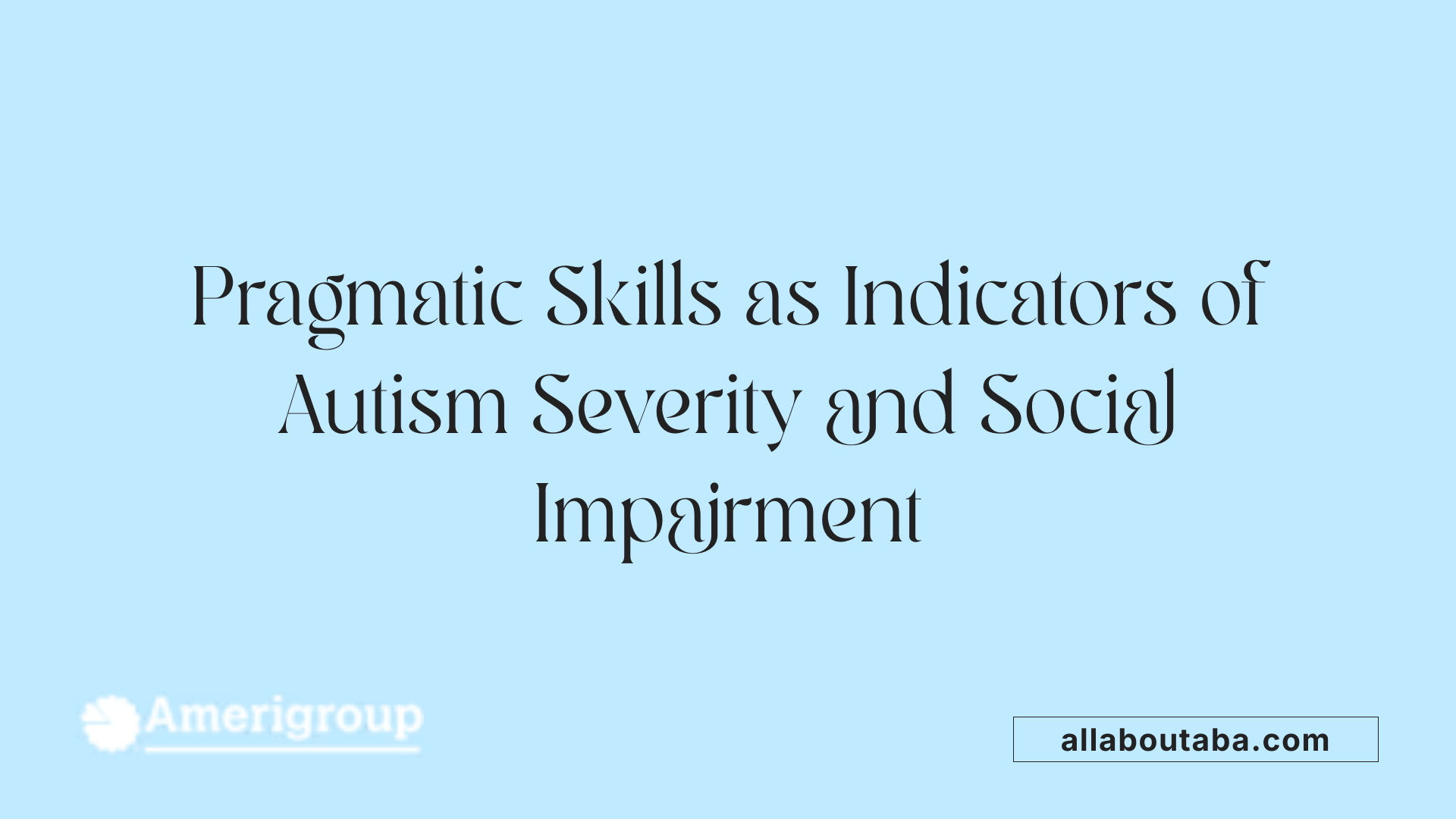
How are pragmatic language deficits correlated with social impairment severity in autism?
Pragmatic language difficulties are deeply intertwined with the severity of social impairments in children with Autism Spectrum Disorder (ASD). These difficulties involve challenges in the social use of language, such as managing topics, responding appropriately, and understanding non-verbal cues. Research has shown that within children diagnosed with ASD, those with more pronounced pragmatic language impairments tend to exhibit greater social communication deficits. This relationship is often measured using the Social Responsiveness Scale (SRS-2), a widely used tool that quantifies the severity of social impairments related to autism.
Do pragmatic language scores predict autism severity beyond IQ and other developmental factors?
Yes, pragmatic language scores provide robust predictive information about autism severity that goes beyond a child's intelligence quotient (IQ) and other background developmental factors. Studies using parent-reported tools like the Children's Communication Checklist, 2nd Edition (CCC-2), reveal that pragmatic language assessments strongly differentiate children with ASD from those with typical development or other disorders such as ADHD. Unlike structural language scores, pragmatic scores are less affected by IQ variations, making them a more precise indicator of social communication deficits that characterize autism severity.
How is the Social Responsiveness Scale (SRS-2) utilized in examining this relationship?
The SRS-2 is integral in examining the link between pragmatic language deficits and social impairment severity. It systematically measures social deficits and autistic traits across a continuum, offering quantifiable data that correlate with pragmatic language performance. When combined with parent-report measures like the CCC-2, the SRS-2 helps clinicians and researchers assess how pronounced pragmatic difficulties are within an individual's broader social functioning. This dual assessment approach strengthens the diagnostic process and informs targeted interventions focused on improving social communication in children with ASD.
Link Between Pragmatic Language and Externalizing Behavioral Disorders

Co-occurring Psychiatric Disorders in ASD
Autism Spectrum Disorder (ASD) is frequently accompanied by other psychiatric disorders, with attention-deficit/hyperactivity disorder (ADHD) and oppositional defiant disorder (ODD) appearing at notably high rates. Clinical samples report that up to 83% of children with ASD also exhibit ADHD symptoms, while ODD affects approximately 73%. This high co-occurrence underlines the complexity of behavioral challenges within the autistic population.
Association of Pragmatic Deficits with Disruptive Behaviors
Pragmatic language impairments—the difficulties in using language socially and contextually—are central to ASD but also connect closely with externalizing behavioral problems like ADHD and ODD. Research indicates that children with weaker pragmatic skills often show increased disruptive behaviors, such as impulsivity, defiance, and social rule-breaking. For example, pragmatic difficulties in autistic children predict higher levels of anxiety, antisocial behaviors, and externalizing symptoms, especially ADHD-related behaviors.
Behavioral Implications of Pragmatic Impairments
These language challenges extend from early childhood into adolescence and adulthood, creating larger social communication barriers. Pragmatic deficits affect a child's ability to manage conversations, interpret social cues, and adjust communication appropriately. This leads to frustration and behavioral outbursts, contributing to externalizing symptoms. Studies also show that improvements in pragmatic language correlate with reductions in such behaviors, highlighting the importance of interventions targeting social communication abilities.
Parent-report measures such as the Children's Communication Checklist (CCC-2) have been effective in identifying pragmatic challenges and their behavioral associations. Notably, a subset of individuals who no longer meet ASD diagnostic criteria exhibits ameliorated pragmatic language skills alongside fewer externalizing behaviors, suggesting that enhancement of these skills may reduce disruptive behavior. Thus, pragmatic language abilities serve as both diagnostic markers and targets for intervention to mitigate behavioral difficulties associated with ASD.
Neural Basis of Pragmatic Language Processing in Autism

Which brain regions are involved in pragmatic language processing in children with ASD?
Pragmatic language processing in children with Autism Spectrum Disorder (ASD) engages several critical brain regions. Key areas include the medial prefrontal cortex, which is fundamental for understanding others' intentions and social cognition. The temporal lobe plays a vital role in processing auditory information and language comprehension, while limbic networks contribute to emotional processing crucial for social communication. Additionally, the Default Mode Network (DMN), involved in self-referential thought and social information processing, shows atypical patterns in individuals with ASD, impacting pragmatic language abilities.
How do neural mechanisms differ in ASD despite similar behavioral responses?
Though children with ASD may perform similarly to typically developing peers during pragmatic language tasks, neuroimaging studies reveal distinct underlying neural mechanisms. Differences in activation and connectivity within the medial prefrontal cortex, temporal regions, and limbic systems suggest compensatory or alternative pathways being used during social communication. These neural distinctions highlight that comparable behaviors do not always reflect similar brain function, emphasizing the complexity of pragmatic impairments in ASD.
What insights have neuroimaging techniques provided about pragmatic language in autism?
Advanced neuroimaging, such as Magnetic Resonance Imaging (MRI), has deepened our understanding of pragmatic language impairments in ASD. Imaging reveals altered structure and function in brain regions responsible for interpreting social cues and non-literal language. These findings support the development of targeted interventions by identifying specific neural substrates involved in pragmatic difficulties. Moreover, neuroimaging aids in tracking intervention outcomes by visualizing changes in brain connectivity associated with improved social communication skills.
Contributing Factors to Pragmatic Language Difficulties in ASD
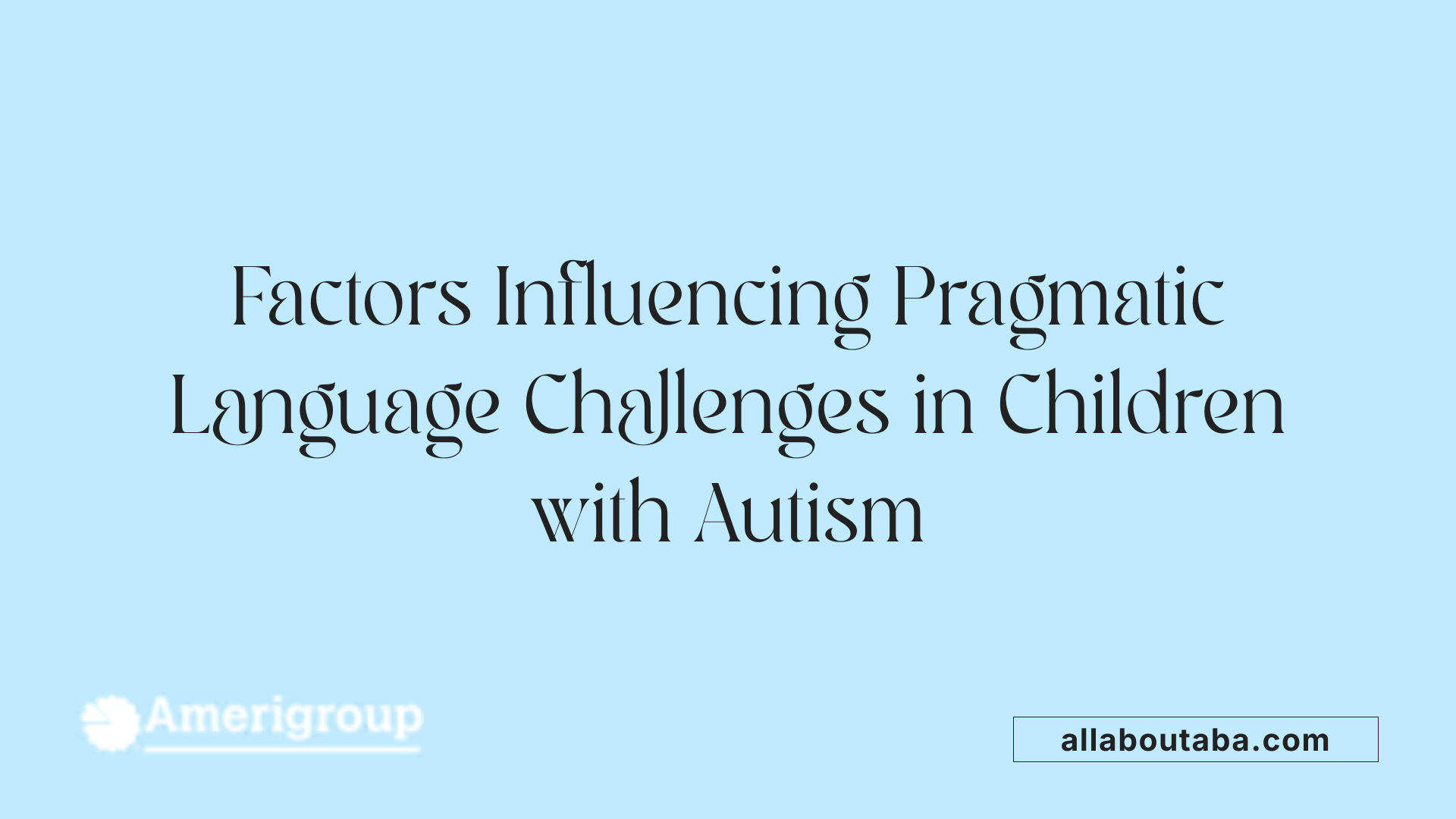
What factors contribute to pragmatic language difficulties in children with ASD?
Pragmatic language difficulties in children with Autism Spectrum Disorder (ASD) arise from multiple interrelated factors. One significant contributor is structural language deficits, which involve challenges with grammar, vocabulary, and sentence formation. These foundational language impairments often limit children's ability to organize and convey messages effectively in social contexts.
Another critical factor is Theory of Mind (ToM) impairments. ToM refers to the ability to understand others' intentions, beliefs, and emotions. Children with ASD frequently struggle with this cognitive skill, affecting how they interpret implied meanings, metaphors, and non-literal language. Such deficits hinder their capacity to grasp social cues and adjust conversations appropriately.
Executive function challenges also play an important role. Difficulties in planning, cognitive flexibility, and self-regulation can impact how children with ASD take turns in conversations or respond to changing social situations. These cognitive constraints make pragmatic social interactions more demanding.
Lastly, the influence of parental pragmatic skills has been noted. Parental communication styles and pragmatic competencies can shape children's pragmatic development. Positive parent-child interactions marked by supported joint engagement correlate with improved pragmatic abilities later in childhood. Conversely, limited parental pragmatic skills may contribute to ongoing difficulties.
Recognizing these factors is vital for designing targeted interventions that address not only language structure but also social cognition and family dynamics, ultimately supporting better pragmatic outcomes for children with ASD.
Theory of Mind and Its Impact on Pragmatic Language in Autism
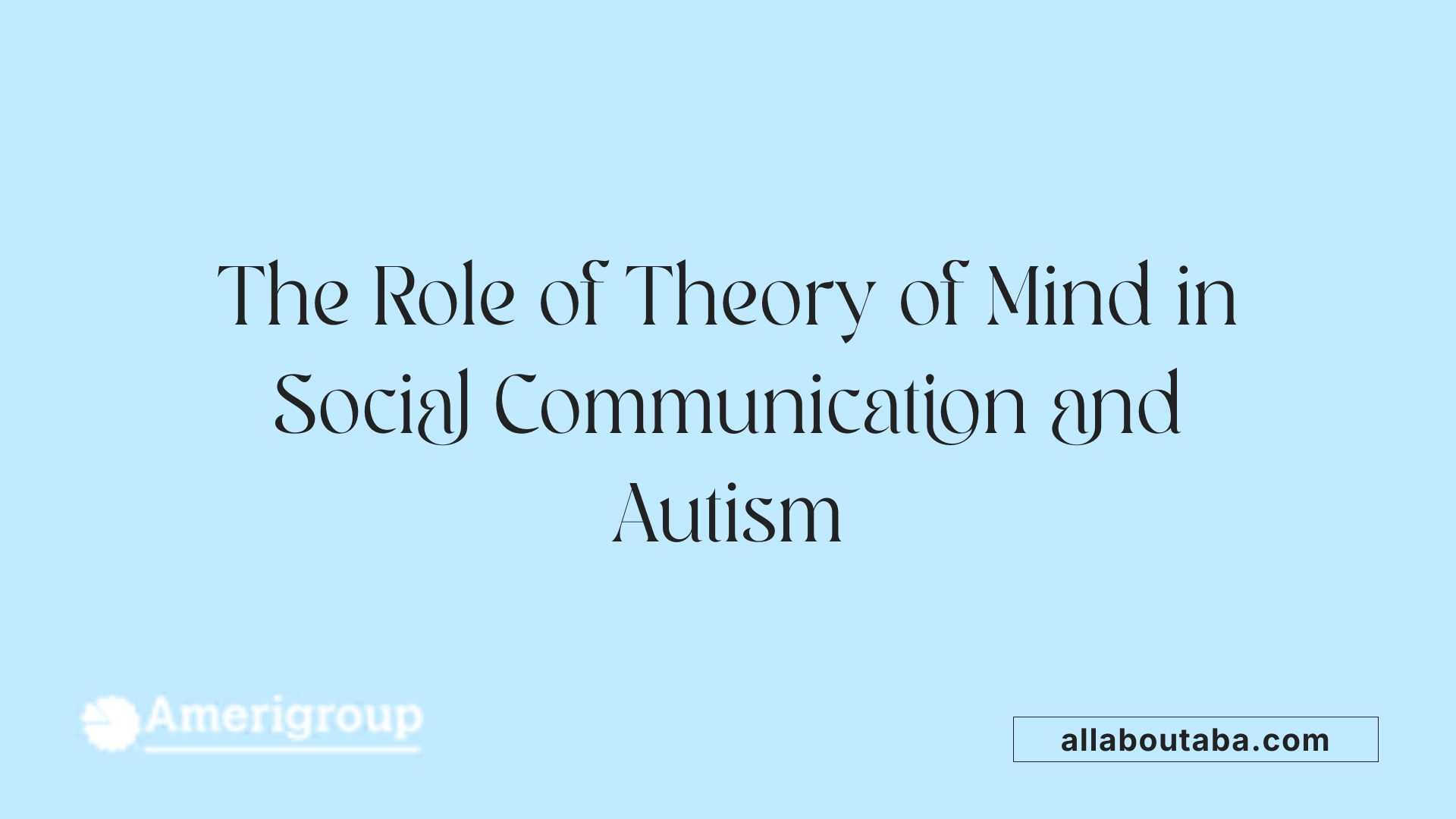
Understanding Others' Intentions, Metaphors, and Non-Literal Language
Theory of Mind (ToM) refers to the ability to comprehend and infer the thoughts, feelings, and intentions of others. In children with autism spectrum disorder (ASD), deficits in ToM significantly affect their pragmatic language skills. These children often struggle to understand metaphors, idioms, sarcasm, and other forms of non-literal language, which require insight into the speaker's intended meaning beyond the literal words.
Relation to Social Communication Challenges
Pragmatic language encompasses how individuals adjust their speech according to social context, engage in turn-taking, and interpret implied meanings. When children with ASD have impaired ToM, they face challenges in social communication such as poor topic management, difficulties in maintaining conversations, and reduced social reciprocity. These deficits contribute to impaired peer relations and increased behavioral issues, highlighting the essential role of ToM in effective social interaction.
Research Emphasis on ToM Deficits
Recent research underscores the link between ToM impairments and pragmatic language difficulties in autism. This focus has driven studies exploring interventions that target both social cognition and communication abilities. Understanding how ToM deficits contribute to pragmatic impairments helps clinicians and educators develop targeted therapies to improve social language use and overall social functioning in children with ASD.
Importance of Joint Engagement in Early Pragmatic Development

What is Supported Joint Engagement (SJE) and Why Does It Matter?
Supported joint engagement (SJE) refers to interactive moments when a child and caregiver share attention closely on an activity or object, with the adult supporting the child's participation. This shared focus lays the foundation for essential communication and social skills by encouraging the child to engage in social exchanges. In children with autism spectrum disorder (ASD), early SJE promotes the development of pragmatic language abilities—skills that govern the social use of language such as taking turns, understanding conversational norms, and adjusting speech according to context.
How Does SJE Predict Later Pragmatic Language Ability?
Research highlights SJE as a strong early predictor of later pragmatic competence in children with ASD. Specifically, higher proportions of supported joint engagement during early parent-child interactions are linked to improved pragmatic language proficiency as the child grows. This correlation persists even when controlling for other factors like structural language abilities, underscoring the unique and critical role of social engagement in pragmatic language development.
What Are the Intervention Implications?
Interventions aimed at enhancing parent-child interactions often focus on increasing SJE to support pragmatic language acquisition. Programs that coach caregivers to actively engage their children in shared activities and responsive communication can foster better social communication outcomes. Such approaches may include guided play, shared book reading, and routines that encourage responsive exchanges. Given that parental pragmatic skills and their ability to support engagement impact child outcomes, caregiver involvement is a vital component of effective interventions. Encouraging joint engagement early helps set the stage for more advanced social communication, ultimately aiding children with ASD in navigating social contexts more effectively.
Impact of Structural Language Abilities on Pragmatic Skills
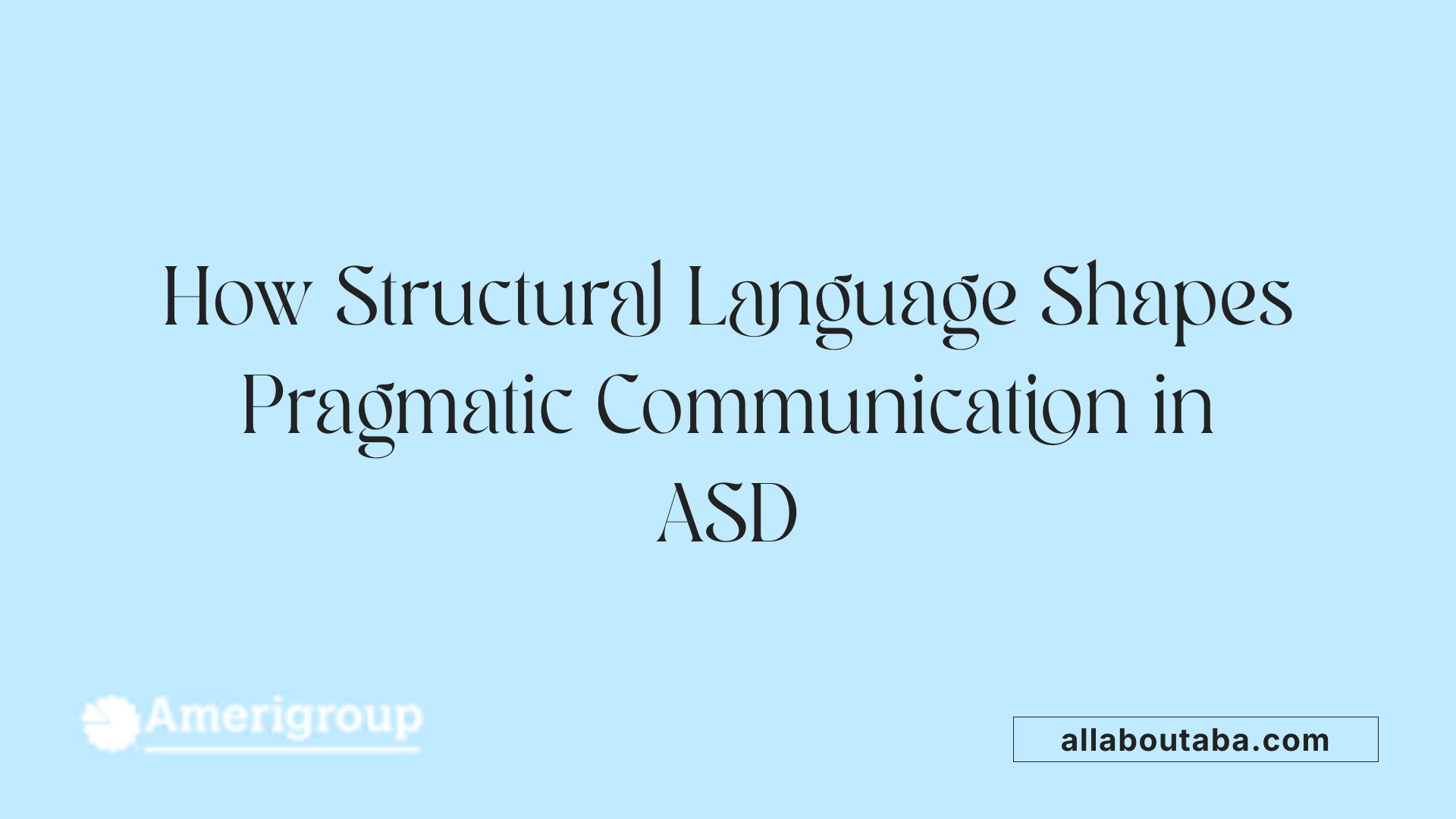
How are structural language abilities related to pragmatic difficulties in children with ASD?
Structural language abilities refer to the foundational components of language such as grammar, vocabulary, and sentence construction. In children with Autism Spectrum Disorder (ASD), these structural language skills are closely connected to pragmatic language difficulties, which involve the social use of language in context. Research shows that impairments in structural language often coexist with, and can exacerbate, challenges in pragmatic communication.
For example, a child with limited vocabulary or grammar may struggle to organize thoughts effectively, which negatively affects their ability to manage topics, respond on topic, and adjust speech appropriate to different social contexts. This relationship means that improving structural language may indirectly support better pragmatic skills.
How does the interplay between structural and pragmatic language affect communication outcomes?
The interplay of structural and pragmatic language abilities greatly influences overall communication success. Structural deficits can constrain the content and clarity of messages, but pragmatic difficulties impact the interpretation and appropriateness of these messages in social interactions.
This complex relationship affects not only spoken language but also non-verbal communication, social reciprocity, and turn-taking — core challenges in ASD. When both areas are affected, children are at greater risk for social isolation and behavioral problems, including externalizing behaviors like ADHD symptoms.
What are the assessment considerations regarding structural and pragmatic language?
Assessment tools such as the Children’s Communication Checklist-2 (CCC-2) differentiate between structural and pragmatic language abilities. Notably, pragmatic scores tend to be less influenced by IQ than structural language scores, making them especially informative about social communication deficits.
Clinicians should conduct multidimensional assessments combining parent reports, like the CCC-2, and direct clinician evaluation to capture the full scope of language abilities. Understanding the contributions of structural language deficits allows for more targeted interventions that address both linguistic foundations and the social use of language.
| Aspect | Description | Implication for ASD Intervention |
|---|---|---|
| Structural Language | Grammar, vocabulary, sentence construction | Foundation for clear language; target early to support pragmatics |
| Pragmatic Language | Social use of language, context adjustment | Core communication challenge; requires social-pragmatic focus |
| Assessment | Combine parent-report and clinician assessment | Essential for accurate diagnosis and individualized therapy |
| Communication Outcomes | Dependent on both structural and pragmatic skills | Holistic interventions improve social functioning and reduce behavioral issues |
Overview of Pragmatic Language Intervention Approaches for ASD
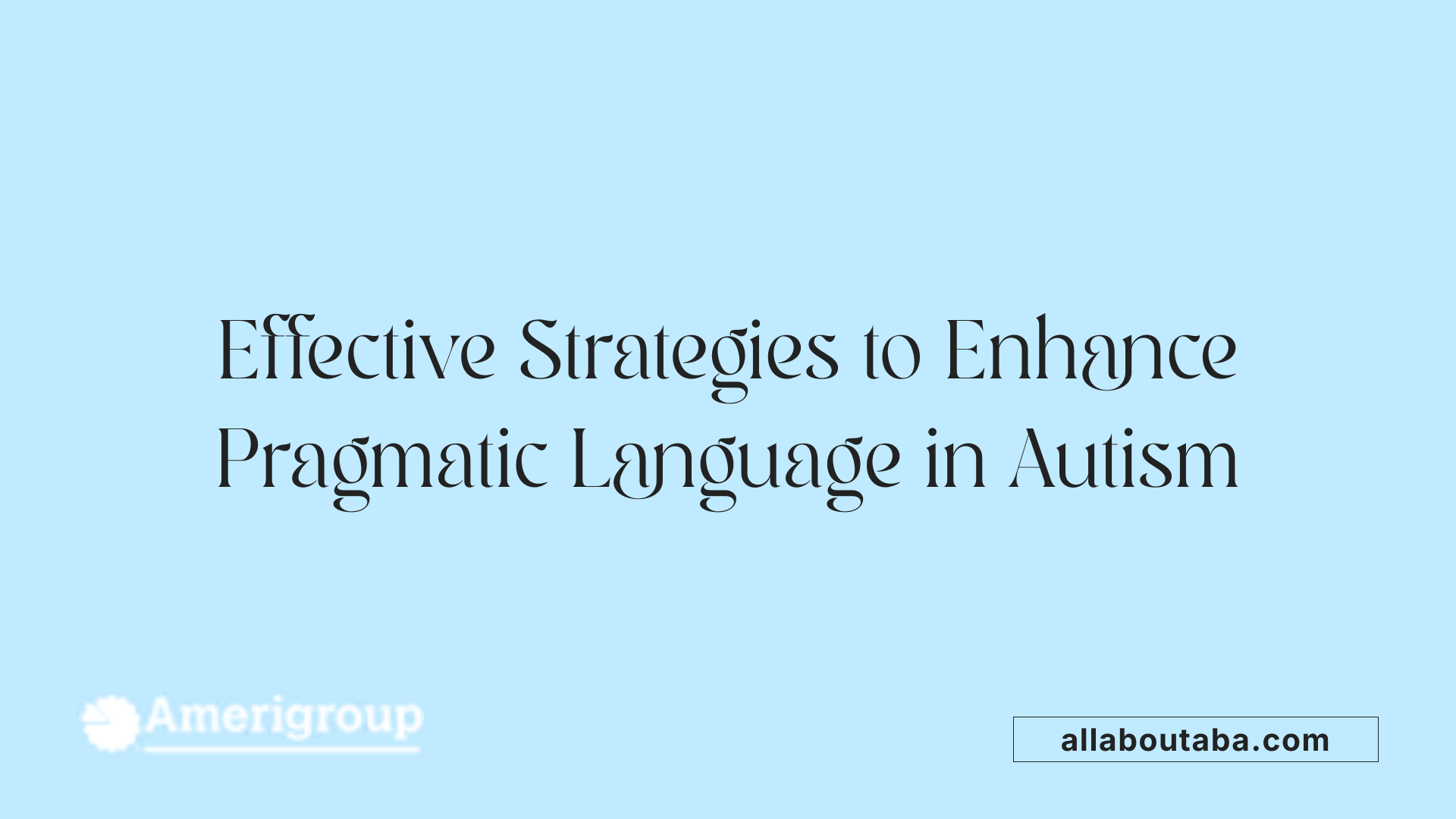
Range of Intervention Strategies
Pragmatic language interventions for children with Autism Spectrum Disorder (ASD) encompass a broad spectrum of methods designed to improve social communication skills.
Interventions often target multiple domains including introduction and responsiveness, non-verbal communication, social-emotional attunement, executive function, and negotiation skills. Most programs emphasize the first three domains as these are foundational for pragmatic development.
Motor Imitation, Social Stories, AAC Tools
Some common approaches include motor imitation activities that help children mirror and learn social gestures and behaviors, fostering engagement and interaction.
Social stories are tailored narratives that explain social situations and expected responses in a concrete and accessible way, aiding children in understanding unspoken social rules.
Augmentative and Alternative Communication (AAC) tools support children who face challenges with verbal communication by providing alternative means such as picture exchange systems, communication apps, or devices that enhance expressive language.
Inclusive Educational Practices
Inclusive educational settings actively incorporate children with ASD alongside their typically developing peers. Group interventions in such environments have shown greater positive impacts compared to individual therapy, as peer interaction naturally promotes pragmatic skill development.
Family involvement is critical across these interventions; caregiver coaching and active participation enhance outcomes by facilitating skill generalization beyond clinical or therapy settings.
Overall, pragmatic language interventions for ASD are multidisciplinary and utilize innovative strategies that address social communication comprehensively and flexibly to meet diverse needs.
Evidence-based Pragmatic Language Therapies and Techniques

Neuroplasticity and Early Intervention
Early intervention targeting pragmatic language in children with autism leverages neuroplasticity, the brain's ability to reorganize and form new connections. Starting therapy during early developmental stages maximizes effectiveness by building foundational social communication skills before challenges become ingrained. Interventions often focus on enhancing joint engagement between caregivers and children, promoting better pragmatic outcomes later in life.
Social Interaction, Play, and Game-Based Activities
Pragmatic language therapies incorporate social interaction, play, and game-based activities to create engaging, naturalistic learning environments. These approaches encourage children to practice conversational rules, non-verbal communication, and social reciprocity. Activities like motor imitation tasks, social stories, and interactive games help children learn to handle turn-taking, topic management, and adjusting speech based on context.
Goal Domains Targeted by Interventions
Interventions typically focus on multiple domains critical to pragmatic language development. These include:
- Introduction and Responsiveness: Practicing greetings and initial social exchanges.
- Non-verbal Communication: Developing gestures, eye contact, and facial expressions.
- Social-emotional Attunement: Understanding and responding to others' emotions and intentions.
- Executive Function: Enhancing planning and flexibility in communication.
- Negotiation Skills: Managing conversations and social problem-solving.
Most therapies prioritize the first three domains, with clinical settings showing stronger effects compared to home or school-based interventions. Family involvement, especially parent coaching, significantly improves outcomes by fostering skill generalization across environments.
Importance of Active Child and Parent Participation in Therapy
Why Is Caregiver Coaching and Family Involvement Crucial?
Caregiver coaching and family involvement form the cornerstone of effective pragmatic language interventions for children with autism spectrum disorder. Engaging parents actively in therapy allows for consistent reinforcement of pragmatic skills beyond clinical settings. This involvement nurtures supportive environments where children practice social communication naturally, enhancing real-world applicability.
How Does Participation Mediate Positive Intervention Outcomes?
Active participation by children and their parents significantly mediates positive outcomes. Studies reveal that interventions incorporating caregiver coaching produce larger effect sizes compared to those focusing solely on the child. Parents become skilled collaborators who can tailor strategies to their child’s unique needs, enabling personalized and flexible support.
In What Ways Does Family Engagement Enhance Skill Generalization?
Family involvement also supports generalization of learned pragmatic skills across multiple environments, such as home and school. Since pragmatic language is context-dependent, ongoing practice with familiar adults helps children adapt language use to various social situations. This continuity improves social participation, emotional expression, and communication confidence.
Integrating caregivers and children as active partners in therapy is therefore essential for promoting sustainable improvements in pragmatic language abilities, ultimately fostering better social outcomes for children with ASD.
Effectiveness of Group Versus Individual Pragmatic Interventions

Larger Impact of Peer-Involved Group Interventions
Research indicates that group interventions for pragmatic language skills tend to produce more substantial positive outcomes compared to individual therapy sessions for children with autism spectrum disorder (ASD). A critical element contributing to these enhanced effects is the active involvement of peers, which embeds social communication skills practice within naturalistic interactions. These peer-involved sessions allow children to navigate real-life social cues and conversational nuances, fostering a richer learning environment.
Inclusion of Typically Developing Peers
Among peer-inclusive group interventions, programs that incorporate typically developing peers have shown particularly beneficial impacts. The presence of typically developing children establishes more normative social models and communication patterns, which children with ASD can observe and emulate. This inclusion not only boosts pragmatic skill acquisition but also supports social integration and relationship building, enhancing generalization of skills beyond the intervention setting.
Comparison of Clinical Versus Home/School Settings
Intervention outcomes appear strongest when delivered in clinical settings compared to home or school environments. Clinic-based programs often offer structured, intensive sessions led by trained professionals, which may explain their superior effectiveness. However, the limited number of studies conducted outside clinical contexts calls for cautious interpretation of these findings. While home and school-based interventions provide ecological validity and generalization opportunities, further research is needed to optimize their design and delivery for maximal pragmatic language benefits.
In summary, group interventions that involve peers—especially typically developing peers—and are delivered in clinical environments tend to have a larger impact on pragmatic language development in children with ASD than individual therapy or interventions in less controlled settings.
Assessment Methods for Measuring Pragmatic Language Outcomes
Observational measures and ecological validity
Observational measures involve directly watching and coding children's pragmatic language behaviors in naturalistic or structured settings. These measures provide strong ecological validity, capturing how children use language in real social interactions. However, challenges include variability in the settings and potential observer biases, which can affect consistency.
Parent reports and lab assessments
Parent-report tools like the Children’s Communication Checklist, 2nd Edition (CCC-2) are widely used for pragmatic language assessment. These tools offer valuable insights into children’s everyday social communication from those who know them best, complementing clinical evaluation. Lab-based assessments offer controlled environments to test specific pragmatic tasks but may not fully reflect everyday communication abilities.
Challenges with psychometric properties
Many observational measures lack comprehensive psychometric validation, which raises concerns about reliability and validity. Parent reports, while ecologically sound, depend on informant accuracy and may be influenced by subjective perceptions. Balancing multiple assessment methods is crucial to gain a comprehensive, reliable understanding of pragmatic language outcomes in children with ASD.
Long-Term Effects and Generalization Challenges in Pragmatic Language Intervention

Why is knowledge about skill maintenance outside clinical environments limited?
Most existing studies on pragmatic language interventions for children with ASD focus on immediate or short-term outcomes within controlled clinical settings. This narrow scope means there is scarce data on how well children maintain and apply their pragmatic skills once they leave these environments. Additionally, the complexities of everyday social contexts, which vary widely, are challenging to replicate and assess comprehensively in research, contributing to this knowledge gap.
What is the need for longitudinal research in this area?
Longitudinal studies are essential to track the durability of pragmatic language improvements over extended periods and across different environments like home, school, and social settings. Such research would illuminate whether gains from interventions persist into adolescence and beyond, aiding in identifying critical windows where further support might be necessary. It would also provide insights into which intervention elements most effectively promote lasting, generalized skills.
How do these challenges impact therapy planning?
The uncertainty around long-term generalization necessitates that clinicians and educators design interventions incorporating caregiver involvement and real-life context applications to encourage skill transfer. Intervention plans should be flexible, allowing for booster sessions and adaptations as children grow and their social communication demands evolve. Recognizing that improvements in pragmatic skills correlate with reductions in behavioral problems, sustained focus on these areas is vital for holistic developmental progress.
This need for extended understanding underscores the importance of integrating multidisciplinary approaches and real-world practice opportunities when planning and delivering pragmatic language therapies to children with ASD.
Applied Behavior Analysis (ABA) Therapy in Autism Treatment
What is Applied Behavior Analysis (ABA) therapy and how is it used in autism treatment?
Applied Behavior Analysis (ABA) therapy is a scientifically validated method designed to understand and change behavior by applying learning principles such as positive reinforcement. This approach is commonly used in autism treatment to develop vital skills, including communication, social interaction, and daily living activities, while also addressing problematic behaviors.
ABA programs are highly individualized to meet the specific needs of each person with autism. Professionals, such as Board Certified Behavior Analysts (BCBAs), design, oversee, and modify these programs based on continual data collection and assessment. This dynamic process ensures the therapy is responsive to the individual's progress and challenges.
Common ABA techniques include Discrete Trial Training (DTT), which breaks down skills into small, teachable steps; Pivotal Response Treatment (PRT), which focuses on motivation and natural learning opportunities; and the Early Start Denver Model (ESDM), which integrates ABA with developmental approaches for young children in natural settings.
How are ABA programs customized for individuals?
ABA therapy recognizes that autism is a spectrum; therefore, programs are tailored to each person's unique profile. This customization considers factors like age, cognitive abilities, language skills, and individual interests. Personalized goals might range from improving pragmatic language, such as understanding conversational cues, to mastering daily tasks and reducing anxiety-related behaviors.
Data-driven monitoring helps therapists adjust interventions continuously, ensuring that strategies remain effective and relevant. Incorporating family preferences and feedback also enhances the personalization and success of ABA treatment.
Who are the professionals involved in ABA therapy?
ABA therapy involves a team of specialized professionals:
- Board Certified Behavior Analysts (BCBAs): These experts develop and supervise ABA programs, ensuring clinical rigor and individualized care.
- Registered Behavior Technicians (RBTs): They implement the therapy under BCBA supervision, working directly with children to apply behavioral techniques.
- Speech-Language Pathologists: These clinicians often collaborate to enhance communication skills, focusing on pragmatic language development and social communication.
How does ABA therapy support pragmatic language development?
Pragmatic language—the social use of language—is a central challenge for many children with autism. ABA therapy addresses this by teaching conversational rules, turn-taking, greeting, and context-sensitive communication. Therapists use highly structured teaching and naturalistic interactions to promote these skills.
Interventions often include role-playing, social stories, and parent coaching to reinforce pragmatic language use across environments. Since family involvement is crucial, caregivers are supported to practice and generalize these communication skills outside therapy sessions.
Overall, ABA therapy’s comprehensive and adaptive approach makes it a cornerstone treatment, enhancing pragmatic language and other vital skills for individuals with autism.
Providers of Behavioral Analysis and Autism Therapy Services
Who Provides Behavioral Analysis and Autism Therapy Services?
Behavioral analysis and autism therapy services are delivered by specialized organizations and trained professionals who focus on evidence-based interventions tailored to individuals with Autism Spectrum Disorder (ASD). Among these providers are Board-Certified Behavior Analysts (BCBAs), licensed therapists, psychologists, and developmental-behavioral pediatricians. These professionals often collaborate in multidisciplinary teams to address the complex needs of individuals with autism.
Specialized Organizations Offering Autism Therapy
Several notable organizations specialize in delivering autism therapy services. For example, Autism Behavior Services (ABSI) provides individualized Applied Behavior Analysis (ABA) therapy across diverse settings such as homes, schools, and clinics. Their approach emphasizes customizing programs to each child’s unique strengths and challenges.
Autism Learning Partners is another prominent provider recognized for its robust evidence-based programs. They prioritize family collaboration, ensuring that parents and caregivers play an active role in intervention and skill generalization outside therapy sessions.
The Boone Fetter Clinic offers comprehensive autism evaluations, diagnoses, and tailored treatment plans. This center integrates multidisciplinary assessments and therapies, including speech-language therapy, occupational therapy, and feeding interventions, to support the broad spectrum of developmental needs in children with ASD.
Easterseals Southern California contributes comprehensive autism services, including ABA therapy. Their approach focuses heavily on fostering communication and social skills, with a strong emphasis on involving families actively throughout the therapeutic process.
Multidisciplinary Approaches for Holistic Support
Across these providers, a common thread is the incorporation of multidisciplinary approaches. Therapies often cover a range of areas to promote holistic development, such as:
- Speech therapy: Enhancing pragmatic language skills and effective communication.
- Occupational therapy: Supporting daily living skills and sensory integration.
- Feeding therapy: Addressing challenges related to eating behaviors and nutrition.
By integrating these disciplines, providers can more comprehensively support social communication, behavioral regulation, and adaptive functioning.
In sum, organizations like Autism Behavior Services (ABSI), Autism Learning Partners, Boone Fetter Clinic, and Easterseals Southern California illustrate the range of providers delivering behavioral analysis and autism therapy services. Their multidisciplinary, evidence-based, and family-centered practices play a pivotal role in improving outcomes for children and families navigating autism.
Primary Goals of Autism Therapy Based on Behavioral Analysis
What are the main goals of autism therapy based on behavioral analysis?
Autism therapy based on behavioral analysis, particularly Applied Behavior Analysis (ABA), focuses on increasing helpful behaviors while reducing harmful or obstructive ones. The overarching aim is to improve essential areas such as communication, social skills, and daily living abilities, which are often challenging for individuals with autism spectrum disorder (ASD).
A central goal is to enhance both expressive and receptive language skills. This includes teaching children how to request needs or objects, label items or emotions, and understand social cues — all critical components for meaningful communication. Therapy also targets social interactions by fostering skills like turn-taking, responding appropriately in conversations, and recognizing emotions in themselves and others.
Developing independence in everyday routines is another vital objective. This encompasses self-care tasks such as dressing, grooming, and participating in community activities. By gaining these skills, individuals can experience greater autonomy in their daily lives.
A significant focus of behavioral therapy is the reduction of problematic behaviors that interfere with learning, socialization, and overall well-being. These behaviors may include aggression, self-injury, or repetitive actions that limit engagement with others or the environment.
Goals are tailored specifically to each individual's unique needs and developmental level. This personalization is achieved through comprehensive assessments and ongoing data tracking, enabling therapists to adjust strategies effectively.
Positive reinforcement is a core method used throughout therapy to motivate and encourage desired behaviors. By rewarding progress, children are more likely to build and maintain new skills over time.
Ultimately, the aim of behavioral analysis-based autism therapy is to help individuals achieve greater functional independence, build meaningful social connections, and improve their overall quality of life.
Role of Speech Therapy in Supporting Pragmatic Language Skills
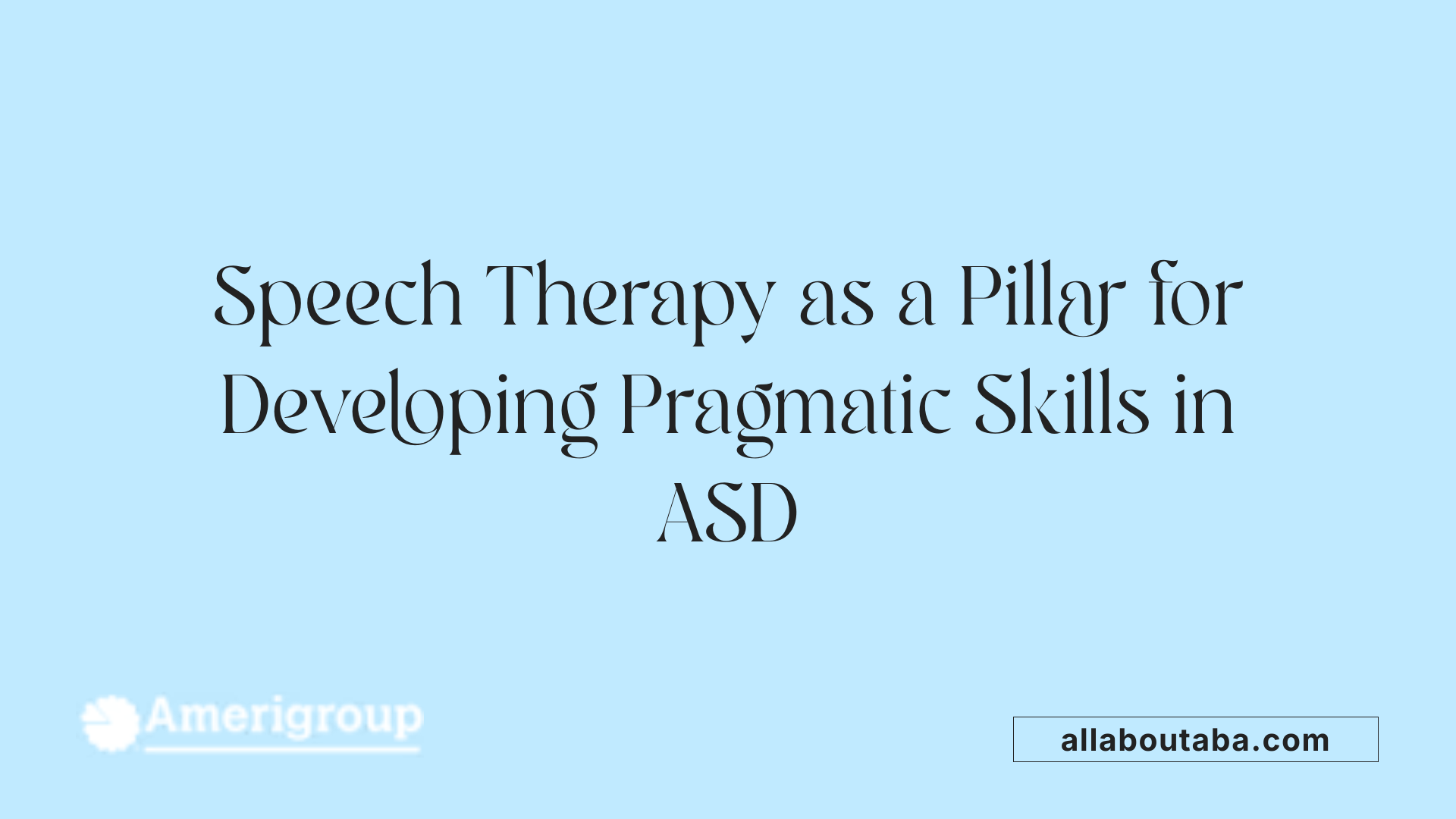
Teaching Conversational Rules and Turn-Taking
Speech therapy plays a crucial role in helping children with autism spectrum disorder (ASD) develop pragmatic language skills by explicitly teaching conversational rules. These include turn-taking during conversations, maintaining appropriate topics, and understanding social norms around greetings and farewells. Speech-language pathologists break down these complex social interactions into smaller, manageable steps to improve communication effectiveness.
Improving Social Reciprocity
Alongside conversational skills, speech therapy focuses on enhancing social reciprocity, or the back-and-forth flow of social communication. Children learn how to respond appropriately to others’ speech, recognize non-verbal cues like facial expressions and gestures, and adjust their language based on different social contexts. Strengthening these skills helps autistic children engage more meaningfully with peers and adults.
Collaboration with ABA and Other Therapies
Speech therapy often works in collaboration with Applied Behavior Analysis (ABA) therapy and other interventions. While ABA therapy emphasizes breaking behaviors into teachable parts and uses data-driven reinforcement strategies, speech therapy specifically targets the social use of language. Coordinated approaches involving Board Certified Behavior Analysts (BCBAs), Registered Behavior Technicians (RBTs), and speech-language pathologists ensure that pragmatic language skills are reinforced in multiple settings.
Parental involvement is an essential component, with caregivers coached to support the use of pragmatic strategies at home and school. This teamwork across disciplines helps children generalize the learned skills, promoting successful social participation and improved communication confidence.
Family and School Supports to Reinforce Pragmatic Language Development

In-school and after-school supports
Children with autism spectrum disorder (ASD) benefit greatly from structured supports both during and after school hours. These settings provide opportunities where pragmatic language skills can be practiced within naturalistic social contexts. In-school supports often include speech therapy sessions and social skills groups, where professionals such as speech-language pathologists and Board Certified Behavior Analysts (BCBAs) use evidence-based strategies to teach conversation skills, turn-taking, and non-verbal communication.
After-school programs and clubs offer additional chances for children to apply pragmatic language in informal peer interactions. These activities foster social participation and help children navigate the social nuances that are challenging for them.
Generalization of skills across environments
One of the main challenges in pragmatic language intervention is helping children with ASD generalize learned communication skills beyond clinical or therapy settings. Consistent practice across multiple environments—home, school, and social settings—is crucial for meaningful progress. Family involvement is key to this process, as parents and caregivers can reinforce strategies taught in therapy sessions and encourage their child to use pragmatic skills during daily routines and interactions.
Collaboration between caregivers and educators ensures that children receive consistent messages and support, increasing the likelihood that pragmatic language improvements will transfer to real-world situations.
Collaboration between families, clinicians, and educators
Effective reinforcement of pragmatic language development requires close collaboration between families, clinicians, and school personnel. Parents bring vital insights about their child's communication strengths and challenges in everyday life. Clinicians provide targeted interventions and coach families on supporting pragmatic skills at home.
Educators play an important role by integrating pragmatic language goals into the classroom environment and facilitating peer interactions that build social competence. When all stakeholders communicate regularly and plan interventions together, children experience a cohesive support network that enhances learning and helps them engage more successfully with peers and adults.
This multidisciplinary approach aligns with best practices and promotes holistic development in children with ASD, empowering them to improve social communication and increase confidence across settings.
Interconnected Nature of Pragmatic Language Deficits and Social Behavior in ASD
How are pragmatic language deficits linked to peer relationships and emotional expression in ASD?
Pragmatic language skills fundamentally shape how children on the autism spectrum interact socially. Deficits in pragmatic language—such as challenges with conversational turn-taking, topic management, or recognizing social cues—often contribute to difficulties in forming and maintaining peer relationships. These communication gaps can lead to misinterpretations, reduced social reciprocity, and limited emotional expression, resulting in feelings of isolation or misunderstanding in social contexts.
What impact do pragmatic difficulties have on social participation and communication confidence?
Children with ASD who struggle with pragmatic communication frequently find social participation challenging. Their ability to adapt language to different environments or interlocutors is diminished, which can negatively affect conversational fluency and engagement. This often results in lower communication confidence, as these children may anticipate or experience social setbacks. The cumulative effect can restrict opportunities for social interaction, impeding development of social skills and emotional bonds.
How do pragmatic language challenges affect the overall quality of life for children with ASD?
Impairments in pragmatic language significantly influence the broader quality of life for autistic children. Difficulties with social communication translate to limitations in academic settings, extracurricular activities, and family interactions. Conversely, enhancing pragmatic abilities has been shown to improve social participation, emotional expression, and communication confidence—facets closely linked to better psychological well-being and enriched life experiences. Interventions that improve pragmatic competencies, particularly when involving caregivers and peers, have the potential to foster more fulfilling social relationships and greater inclusion.
To summarize the interconnected effects:
| Aspect | Impact | Resulting Challenge |
|---|---|---|
| Pragmatic language deficits | Poor topic management, conversational breakdowns | Difficulty forming peer relationships |
| Social participation | Reduced engagement, lower interaction frequency | Lower communication confidence |
| Emotional expression | Limited social reciprocity | Feelings of isolation or misunderstanding |
| Overall quality of life | Impaired academic and social experiences | Reduced psychological well-being |
Understanding these linkages underscores the importance of early, holistic intervention in pragmatic language to support social behavior and improve life outcomes for children with ASD.
Research Trends and Future Directions in Pragmatic Language and Autism
How is neuroimaging advancing research in pragmatic language impairments in ASD?
Recent research increasingly employs advanced neuroimaging techniques such as Magnetic Resonance Imaging (MRI) to explore the neural substrates underlying pragmatic language difficulties in children with Autism Spectrum Disorder (ASD). These technologies have illuminated altered activity in brain regions important for social communication, including the medial prefrontal cortex, temporal lobes, central parietal areas, limbic networks, and the Default Mode Network (DMN). Understanding these neural differences provides critical insights into the specific brain mechanisms that contribute to pragmatic challenges, offering potential biomarkers for diagnosis and targets for intervention.
What role do technology-assisted interventions play in treating pragmatic language deficits?
Technology-assisted interventions are gaining prominence as promising methods to support pragmatic language development. Tools range from computer-based training and virtual reality social skills programs to augmented and alternative communication (AAC) devices. Such technologies offer interactive, engaging environments for practicing social communication skills and can be tailored to individual needs. Early findings suggest these approaches can enhance social interaction and pragmatic abilities, especially when combined with traditional therapies.
Why are multidisciplinary and cross-domain approaches important in this field?
Addressing pragmatic language impairments requires integrating expertise from diverse disciplines such as speech-language pathology, psychology, neuroscience, and education. Multidisciplinary approaches facilitate comprehensive assessment and intervention, considering cognitive, linguistic, social, and neurological factors simultaneously. Cross-domain collaboration also promotes the development of holistic therapies that target the varied challenges faced by children with ASD, from executive functioning to theory of mind deficits, thereby improving overall treatment effectiveness.
What are the emerging focuses concerning intervention efficacy and long-term outcomes?
There is a growing emphasis on evaluating the long-term effectiveness and generalization of pragmatic language interventions beyond clinical settings, an area still underexplored. Researchers are increasingly investigating how intervention benefits sustain into adolescence and adulthood, and how skills transfer to real-world social contexts. Additionally, family involvement, peer group inclusion, and caregiver coaching have been identified as influential factors that mediate positive outcomes. Future research aims to establish evidence-based best practices that maximize lasting improvements.
These research trends signify a shift towards precision, personalized intervention leveraging technological innovations and collaborative expertise, with a strong commitment to meaningful, long-term gains in social communication for individuals with ASD.
Summary of Evidence-Based Practices for Pragmatic Language Intervention
What are the primary intervention strategies for pragmatic language in ASD?
Effective interventions for pragmatic language in children with Autism Spectrum Disorder (ASD) typically target skills across five domains: Introduction and Responsiveness, Non-verbal Communication, Social-emotional Attunement, Executive Function, and Negotiation. Among these, most programs focus on boosting introductory and responsive communication, alongside non-verbal communication, which is a hallmark impairment in ASD.
Clinically delivered interventions have demonstrated more significant benefits than those conducted at home or school settings, though the limited research in non-clinical environments means findings should be cautiously interpreted. Group interventions, particularly those including typically developing peers, often yield larger improvements compared to individual therapy. Parent- and child-inclusive approaches, particularly those involving caregiver coaching, also produce stronger positive effects, underscoring the importance of family involvement.
Why are early, active, and family-centered approaches important?
Early intervention is critical, leveraging neuroplasticity to enhance pragmatic language development through social interaction, play, and game-based activities. Including parents and caregivers actively in therapy leads to better outcomes by mediating intervention effects and supporting skill generalization across different settings. Practices such as motor imitation, social stories, and augmentative and alternative communication (AAC) tools have demonstrated efficacy when caregivers are engaged.
Supported Joint Engagement (SJE) during early parent-child interactions is a strong early predictor of later pragmatic skills, further highlighting the significance of family-centered approaches. Active inclusion encourages naturalistic learning and maintains motivation, making it a cornerstone of evidence-based practices.
What is the need for ecological validity and longitudinal study in pragmatic intervention?
Assessment methods range from observational measures to parent reports and laboratory tests, with observational data providing greater ecological validity but sometimes lacking robust psychometric properties. Despite promising short-term results, the long-term effects and generalization of pragmatic language skills outside of clinical settings remain largely unknown, presenting a critical gap in current research.
There is a pressing need for longitudinal studies to evaluate the sustainability and real-world applicability of intervention outcomes. Such research would provide insights on how pragmatic improvements translate into better social interactions and reduced externalizing behaviors through adolescence and adulthood.
In summary, evidence-based pragmatic language interventions in ASD emphasize early, family-inclusive, and socially contextualized practices. Adopting multidisciplinary, cross-domain approaches with attention to ecological validity and long-term tracking will strengthen support for children with autism in developing essential communication skills.
Towards Enhanced Support for Pragmatic Language in Autism
Pragmatic language impairments constitute a central challenge for individuals with Autism Spectrum Disorder, affecting social communication, behavioral regulation, and overall quality of life. Through validated assessment tools such as the Children’s Communication Checklist-2 and multidisciplinary clinical approaches, clinicians can effectively identify these difficulties early and tailor interventions accordingly. Applied Behavior Analysis therapy, alongside speech therapy and family-focused supports, has demonstrably improved pragmatic skills, social reciprocity, and functional independence. Continuing advances in neuroimaging and technology-assisted methodologies promise to refine our understanding and enhance treatment modalities. Greater emphasis on longitudinal studies and ecological validity will ensure that pragmatic language gains translate into enduring benefits across real-world settings. Ultimately, a collaborative framework involving clinicians, families, educators, and researchers remains essential to optimize outcomes and foster meaningful social engagement for individuals with autism.
References
- Pragmatic Language Markers of Autism Diagnosis and ...
- Pragmatic language and associations with externalizing ...
- Research on pragmatic impairment in autistic children ...
- A systematic review of pragmatic language interventions for ...
- Pragmatics in children with autism spectrum disorder
- Pragmatic performance, its relationship with symptom severity ...
- Supporting Pragmatic Language Growth in Children with ...
Other articles
Recent articles

Understanding Pragmatic Language Difficulties In Autism

The Role Of Dieticians In Autism Support Teams

The Science Of Brain Connectivity In Autism

Best Toys For Building Social Skills In Autism

Cultural Perspectives On Autism Around The World

Autism And Creative Arts As Emotional Expression Tools

Developing Emotional Regulation Skills In Autistic Teens

Best Sensory-Friendly Lighting Solutions For Autism

Cognitive Behavioral Therapy Adaptations For Autism

Best Practices For Autism-Friendly Movie Screenings

Autism And Eating Challenges Beyond Picky Eating

Best Practices For Autism-Friendly Public Transport Design

Best Ways To Foster Collaboration Between Parents And Schools For Autism Support

Supporting Autistic Children During Transitions Between Activities

The Role Of Teachers In Fostering Autism Peer Acceptance

Using Art Therapy To Support Children With Autism

Autism And Strategies For Addressing Sensory Defensiveness

Autism And The Benefits Of Structured Leisure Activities

How To Support Autistic Students During Exam Season

Autism And Goal Setting For Personal Growth

How To Use Gamification In Autism Learning Programs

How Schools Can Reduce Bullying Of Autistic Students

Early Intervention Strategies For Autism Spectrum Disorder

The Role Of Therapists In Autism Life Skills Coaching

How To Support Autistic Individuals In Crisis Situations

Autism And Self-Care Routines For Stress Management

Understanding Echolalia And Its Role In Autism Communication

Autism And Fine Arts Education Benefits

The Impact Of Multisensory Learning On Autism Education

How Family Counseling Supports Autism Household Dynamics

Best Practices For Inclusive Playgrounds For Autism

Best Practices For Autism-Friendly Shopping Centers

How Autism Affects Fine Motor Skill Development

Best Ways To Introduce Sensory Activities Into Daily Routines

How Sports Teams Can Be Inclusive Of Autistic Players

Autism And Strategies For Building Workplace Resilience

Autism And The Impact Of Hormonal Changes During Puberty

How To Support Autistic Students In Foreign Language Classes

Best Ways To Teach Money Skills To Teens With Autism

Supporting Siblings Of Children With Autism

Autism And Co-Occurring Gastrointestinal Disorders

The Role Of Art Projects In Autism Sensory Integration

How Schools Can Incorporate Sensory Break Spaces

Best Practices For Autism Sensory Regulation At School

Autism And Strategies For Teaching Organizational Skills

Understanding The Relationship Between Autism And Anxiety Disorders

Autism And Life Planning For Long-Term Care

Exploring Visual Supports In Autism Education

Ways To Encourage Social Interaction In Children With Autism

The Connection Between Autism And Dyscalculia

The Role Of Occupational Therapy In Transition Planning For Autism

The Role Of Physical Therapists In Autism Motor Skills Support

How To Teach Decision-Making Skills To Autistic Young Adults

The Connection Between Autism And Epilepsy

Best Practices For Transitioning Autistic Children Into New Schools

Autism And Time Management Challenges In Adulthood

The Role Of Visual Arts In Autism Communication Development

How To Address Tactile Defensiveness In Autism

Best Practices For Telehealth Autism Therapy

How To Help Autistic Children Develop Friendship Skills

How Schools Can Support Autistic Students In Career Prep

Best Strategies For Autism-Friendly Event Planning

Understanding Noncontingent Reinforcement In Autism Behavior Plans

How Drama Therapy Benefits Autistic Individuals

Best Practices For Autism-Friendly Fitness And Recreation Centers

Best Ways To Promote Healthy Social Media Use For Autistic Teens

How To Help Autistic Children Cope With Public Speaking

Autism And Strategies For Managing Unexpected Changes

Best Podcasts About Autism For Parents And Educators

Autism And The Impact Of Seasonal Changes On Behavior

The Role Of Diet In Managing Co-Occurring Conditions With Autism

Sleep Challenges In Autism And Practical Solutions

Best Ways To Build Daily Routines For Autistic Children

Best Practices For Supporting Autistic Entrepreneurs

Autism And Strategies For Navigating Large Social Gatherings

Adaptive Sports And Recreational Activities For People With Autism

Autism And The Benefits Of Story-Based Learning Activities

Understanding The Role Of Play In Autism Development

Autism And The Impact Of Environmental Noise On Learning

How To Create Autism-Friendly Community Spaces

Autism And Chronic Health Conditions: What To Know

The Role Of Care Managers In Autism Life Planning

How To Teach Social Boundaries To Autistic Children

How Autistic Individuals Experience Empathy Differently

How To Support Autistic Employees In Remote Work Settings

Autism And The Relationship Between Motor Skills And Learning

How To Create Community Resource Guides For Autism Families

How To Teach Daily Living Skills To Autistic Teens

Autism And The Impact Of Mind-Body Practices On Stress Reduction

Autism And The Benefits Of Outdoor Group Activities

How To Create Autism-Friendly Sensory Paths In Schools

Best Practices For Autism-Friendly Park And Recreation Areas

Autism And Strategies For Reducing School Refusal

Supporting Autistic Individuals In Public Speaking

The Role Of Diet In Managing Autism Symptoms

The Benefits Of Gardening Clubs For Autism Social Development

How To Prepare Autistic Children For Dental Visits

Autism And Employment: Career Paths That Work

Best Practices For Autism-Friendly Hotels And Lodging

The Impact Of Screen Time On Autism Development
We’re All About You, Your Family, and Your Child

